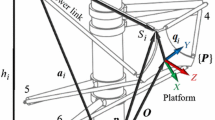Abstract
Hexapod external fixators are the application, in medicine, of industrial parallel manipulators. The first attempts to create parallel manipulators for industrial purposes, date back to the beginnings of the twenty-first century, when several patents for industrial prototypes were released. However, it was only in 1949 that V.E. Gough created the first parallel manipulator with an octahedral configuration, that is, the modern hexapod fixator configuration, in order to test tyres with six degrees of freedom. Later, K. Cappel modified Gough’s original project (Gough-Cappel platform). In 1965, thanks to D. Stewart’s manuscript on a flight simulator platform, the parallel manipulator with six degrees of freedom became known worldwide. The theoretical basis behind the parallel manipulators can be dated back to the fifteenth century; since then, several mathematicians and philosophers became interested in the study of polyhedra (Mozzi, Chasles, Poinsot, Eulero, Ball), their theorems becoming the fundamentals of modern kinematics. The first clinical usage of hexapod fixators in medicine was in 1995, when J.C. Taylor introduced his “Taylor Spatial Frame,” to perform complex limb deformity correction. Many hexapod fixators have been since introduced 1995, not all based on the Gough-Cappel platform.
Access this chapter
Tax calculation will be finalised at checkout
Purchases are for personal use only
Similar content being viewed by others
Abbreviations
- 6-DOF:
-
six degrees of freedom
- MAST:
-
multi-axis simulator table
- SUV:
-
Solomin Utekhin Vilensky
- TSF:
-
Taylor Spatial Frame
- US:
-
United States
References
Mozzi G. Discorso matematico sopra il rotamento momentaneo dei corpi (in Italian). Napoli: Stamperia di Donato Campo; 1763.
Chasles M. Note sur les propriétés générales du système de deux corps semblables entr’eux. Bulletin des Sciences Mathématiques, Astronomiques, Physiques et Chemiques (in French). 1830;14:321–6.
Poinsot. Theorie Nouvelle de la Rotation des Corps. Paris: Bachelier; 1834.
Ball RS. The theory of screws: a study in the dynamics of a rigid body. Foster: Hodges; 1876.
Featherstone R. Robot dynamics algorithms. Boston: Kluwer Academic; 1987. isbn:978-0-89838-230-3.
Featherstone R. Robot dynamics algorithms. New York: Springer; 2008. isbn:978-0-387-74315-8.
Selig JM. Rational interpolation of rigid body motions. In: Advances in the theory of control, signals and systems with physical modeling, lecture notes in control and information sciences, vol. 407. New York: Springer; 2011. p. 213–24.
Kong X, Gosselin C. Type synthesis of parallel mechanisms. New York: Springer; 2007. isbn:978-3-540-71990-8.
Pollard WLG. Spray painting machine. US Patent No. 2,213,108; 26 Aug1940.
Bonev I. The true origins of parallel robots. www.parallemic.org.
Gough VE, Whitehall SG. Universal Tyre test machine. In: Proceedings of the FISITA ninth international technical congress, May 1962. p. 117–37.
Cappel KL. Motion simulator. US Patent No. 3,295,224, 3 Jan 1967.
Stewart D. A platform with six degrees of freedom. In: Proceedings of the IMechE, Vol. 180, Pt. 1, No. 15, 1965–1966. p. 371–85
Moniot P. Dispositif de positionnement tridimensionel de deux piéces quelconques, en particulier de deux parties d’os, et permettant de modifier ledit positionnement. 1985. https://bases-brevets.inpi.fr/en/resultats-de-recherche-simpleen/1535879200927/result.html.
Paley D. History and science behind the six-axis correction external fixation devices in orthopedic surgery. Oper Tech Orthop. 2011;21:125–8.
Solomin LN. The basic principles of external skeletal fixation using the Ilizarov and other devices. 2nd ed. Milan: Springer; 2012. p. 1593.
Taylor JC. The Taylor Spatial Frame fixator. U.S. Pat. No. 5,702,389; 1995.
Seide K, Wolter D. Universal 3-dimensional correction and reposition with the ring fixator using the hexapod configuration. Unfallchirurg. 1996;99(6):422–4. (German).
Solomin L, Vilensky V, Utekhin A. Deformity сorrection and fracture treatment by software-based ortho-SUV frame: user manual. 2013. http://ortho-suv.org. Accessed 12 March 2013.
Author information
Authors and Affiliations
Editor information
Editors and Affiliations
Rights and permissions
Copyright information
© 2021 Springer Nature Switzerland AG
About this chapter
Cite this chapter
Sessa, P., Biancucci, G., Dell’Unto, A., Massobrio, M. (2021). History and Evolution of Hexapod External Fixators. In: Massobrio, M., Mora, R. (eds) Hexapod External Fixator Systems. Springer, Cham. https://doi.org/10.1007/978-3-030-40667-7_1
Download citation
DOI: https://doi.org/10.1007/978-3-030-40667-7_1
Published:
Publisher Name: Springer, Cham
Print ISBN: 978-3-030-40666-0
Online ISBN: 978-3-030-40667-7
eBook Packages: MedicineMedicine (R0)




